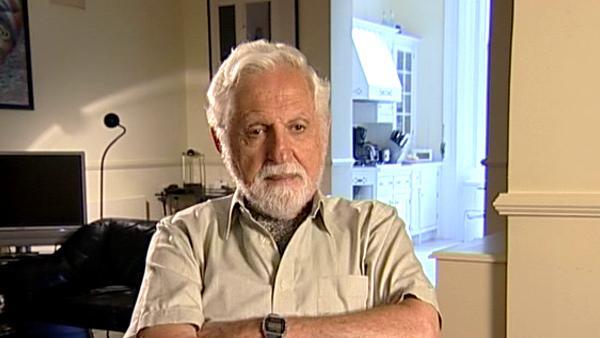So returning to cortisone in 1948. Why is it that cortisone was so much more difficult? Because cortisone... and here is the structure of cortisone and that’s rather easy to see because you can see I... I emphasised in black the really distinguishing thing. First of all, this part here in black is exactly the same thing that you have in progesterone or testosterone. That’s very easy to synthesise from cholesterone. That is a common feature. But cortisone... the adrenal hormone is something else, has an oxygen atom at a position called position 11. That’s unprecedented because no other steroids have that. So that’s in a very inaccessible position and then is a side chain here. In progesterone it is just a simple one. In testosterone it was only OH. You see in cortisone it’s much more complicated. I just don’t even have to tell you what that is, but you can see it is more complicated.
So, the problem in a synthesis of cortisone that people faced was, (A) to generate this – but that was less difficult, not easy but less difficult – but how to introduce an oxygen here in a place where there isn’t any oxygen in cholesterol? Something like that. What Sarett did... that was the first partial synthesis of cortisone, is to convert a bile acid and this is called the oxycholic acid, though it makes no difference... a bile acid and you see the difference there. It has a long acid side chain but people know how to remove it because cholesterol also has a long side chain, except it doesn’t have this. So one already knew how to do that, but it had an oxygen. The natural occurring one in position 12. What he had to learn is how to move it from there to there, and you can’t just pick it up and put it there. This is again any number of steps. So he developed a synthesis of cortisone from the bile acid, which took 40 different chemical steps, and that was at that stage the longest partial synthesis in chemistry.
[Q] Who developed that?
Lewis Sarett, a young... at Merck. And Merck actually manufactured the first few grams... grams of cortisone from bile acid by what was at that time the most complex industrial organic synthesis that had ever been carried out. And, in fact, even to this day is one of the most complicated, but at that time it was unprecedentaly complicated and they accomplished that. The yields were infinitesimal because if you have... if you get an 80% yield in a given chemical transformation that’s a very good yield, and 90% is just superb. But just think about it. If you have a two-step synthesis and you get a 90% yield in each case the overall yield is only 81%. And if you do a three-step synthesis it’s only 72%, and if it’s a four-step synthesis only 56%. You do that 40 times and even if you have a 90% yield you’re getting to a fraction of a percent... final product. So, this is damn expensive, damn complicated.
So, everyone and his grandmother wanted to work on this, and I wanted it to. And I was, you know, was an organic chemist and I was sophisticated and I was ambitious, and I was not permitted to do this at Ciba because that... they, of course, worked on this very hard. That was being done in Basel and some of the real competitors were... there were two groups at Harvard. Woodward, the most famous organic chemist... American organic chemist of the last century. A man named Louis Fieser who was professor of organic chemistry and wrote the most important textbook in steroid chemistry. A man who among other things had worked during the war... very important on antimalarials as well as discovered napalm. So you can see the range is sort of like Fritz Haber in Germany doing both. You know, first poison gases and also nitrogen fixations. You see always black and white issues in... in chemistry. And every one of the pharmaceutical companies. So, everyone was working on this here and I couldn’t.






